Nutritional Evaluation of Soy Products
VerifiedAdded on 2023/04/21
|7
|1394
|86
AI Summary
This document discusses the nutritional evaluation of soy products, including protein needs, protein energy malnutrition disorders, and the health benefits of soy consumption. It also includes a selected soy recipe and personal opinion on soy. The document also mentions an amino acid disorder called phenylketonuria (PKU) and provides references for further reading.
Contribute Materials
Your contribution can guide someone’s learning journey. Share your
documents today.
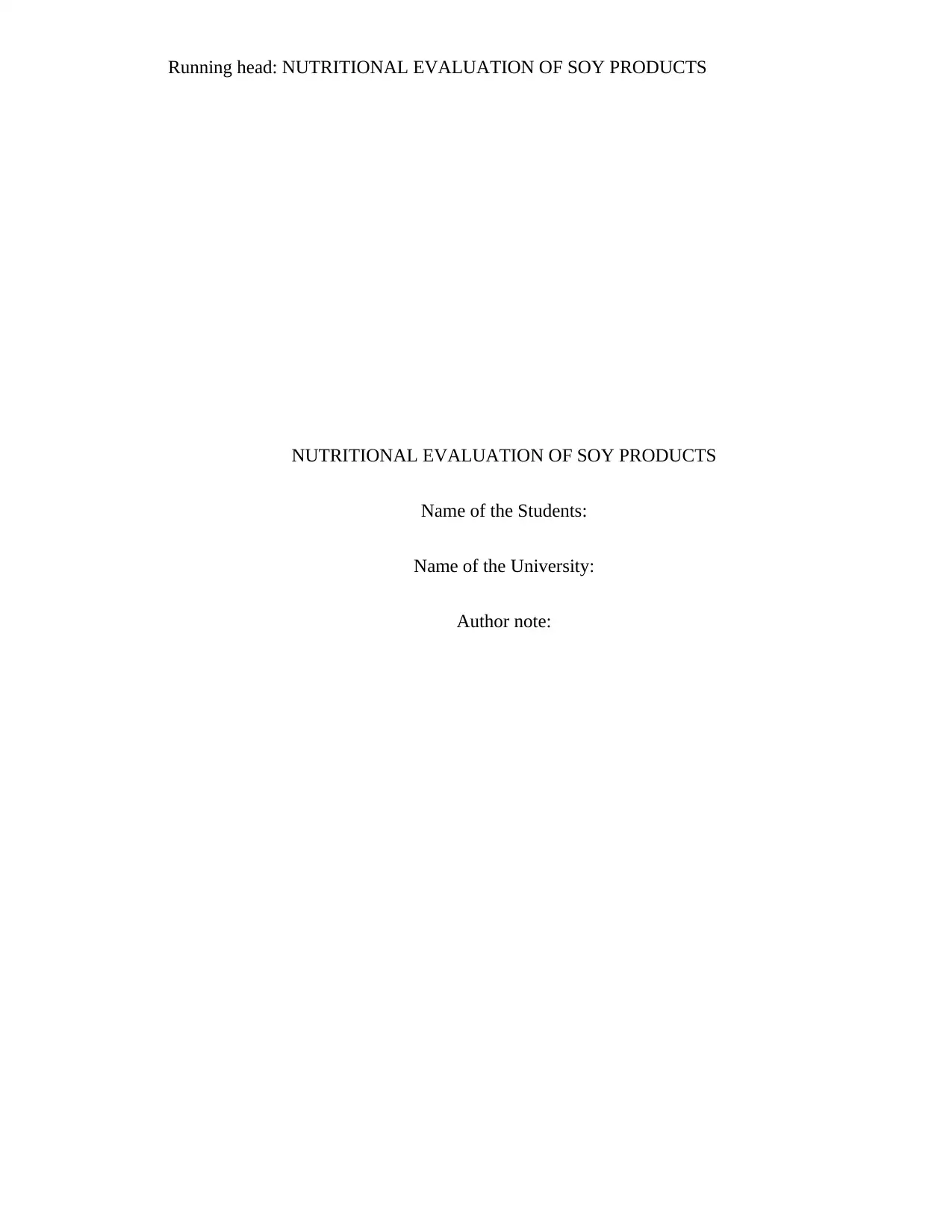
Running head: NUTRITIONAL EVALUATION OF SOY PRODUCTS
NUTRITIONAL EVALUATION OF SOY PRODUCTS
Name of the Students:
Name of the University:
Author note:
NUTRITIONAL EVALUATION OF SOY PRODUCTS
Name of the Students:
Name of the University:
Author note:
Secure Best Marks with AI Grader
Need help grading? Try our AI Grader for instant feedback on your assignments.
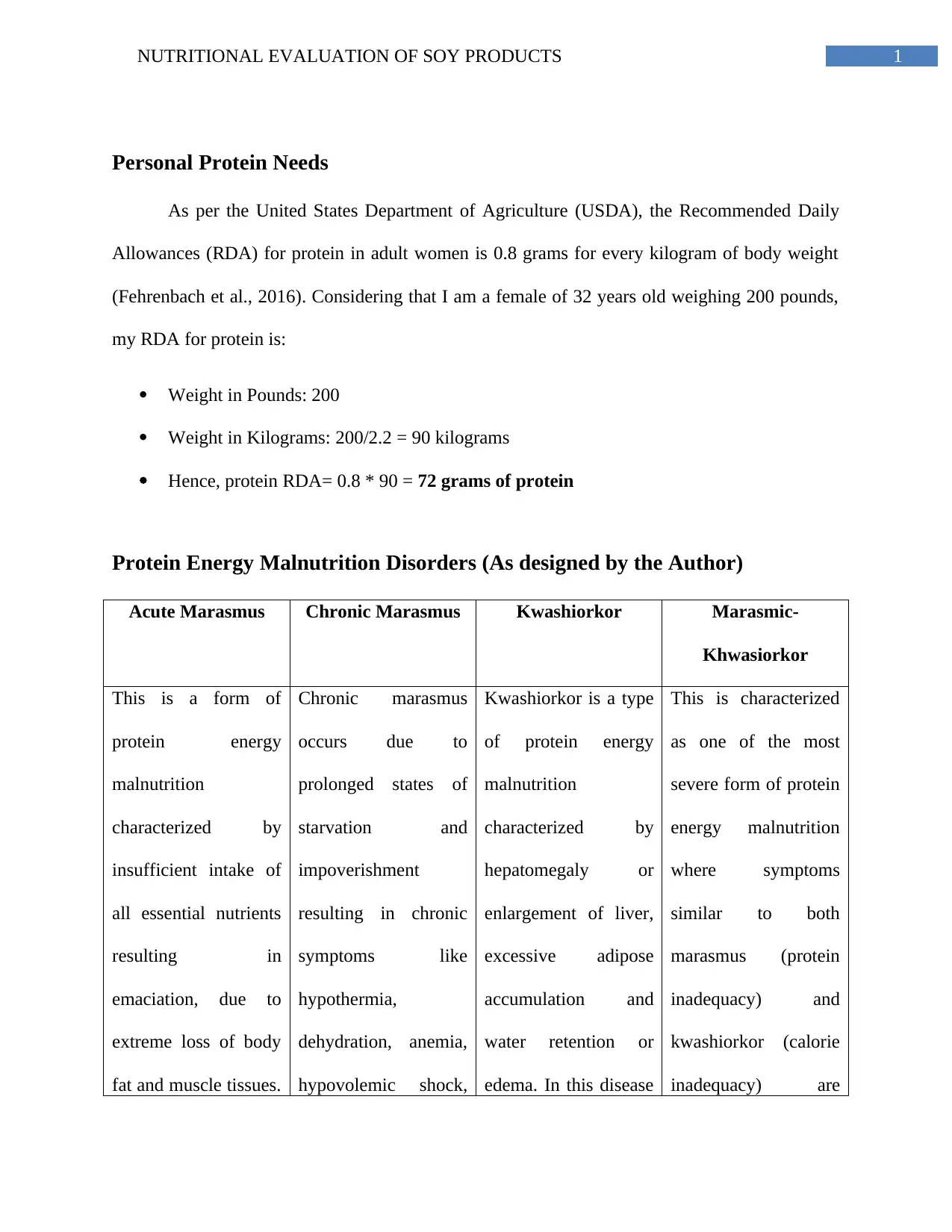
1NUTRITIONAL EVALUATION OF SOY PRODUCTS
Personal Protein Needs
As per the United States Department of Agriculture (USDA), the Recommended Daily
Allowances (RDA) for protein in adult women is 0.8 grams for every kilogram of body weight
(Fehrenbach et al., 2016). Considering that I am a female of 32 years old weighing 200 pounds,
my RDA for protein is:
Weight in Pounds: 200
Weight in Kilograms: 200/2.2 = 90 kilograms
Hence, protein RDA= 0.8 * 90 = 72 grams of protein
Protein Energy Malnutrition Disorders (As designed by the Author)
Acute Marasmus Chronic Marasmus Kwashiorkor Marasmic-
Khwasiorkor
This is a form of
protein energy
malnutrition
characterized by
insufficient intake of
all essential nutrients
resulting in
emaciation, due to
extreme loss of body
fat and muscle tissues.
Chronic marasmus
occurs due to
prolonged states of
starvation and
impoverishment
resulting in chronic
symptoms like
hypothermia,
dehydration, anemia,
hypovolemic shock,
Kwashiorkor is a type
of protein energy
malnutrition
characterized by
hepatomegaly or
enlargement of liver,
excessive adipose
accumulation and
water retention or
edema. In this disease
This is characterized
as one of the most
severe form of protein
energy malnutrition
where symptoms
similar to both
marasmus (protein
inadequacy) and
kwashiorkor (calorie
inadequacy) are
Personal Protein Needs
As per the United States Department of Agriculture (USDA), the Recommended Daily
Allowances (RDA) for protein in adult women is 0.8 grams for every kilogram of body weight
(Fehrenbach et al., 2016). Considering that I am a female of 32 years old weighing 200 pounds,
my RDA for protein is:
Weight in Pounds: 200
Weight in Kilograms: 200/2.2 = 90 kilograms
Hence, protein RDA= 0.8 * 90 = 72 grams of protein
Protein Energy Malnutrition Disorders (As designed by the Author)
Acute Marasmus Chronic Marasmus Kwashiorkor Marasmic-
Khwasiorkor
This is a form of
protein energy
malnutrition
characterized by
insufficient intake of
all essential nutrients
resulting in
emaciation, due to
extreme loss of body
fat and muscle tissues.
Chronic marasmus
occurs due to
prolonged states of
starvation and
impoverishment
resulting in chronic
symptoms like
hypothermia,
dehydration, anemia,
hypovolemic shock,
Kwashiorkor is a type
of protein energy
malnutrition
characterized by
hepatomegaly or
enlargement of liver,
excessive adipose
accumulation and
water retention or
edema. In this disease
This is characterized
as one of the most
severe form of protein
energy malnutrition
where symptoms
similar to both
marasmus (protein
inadequacy) and
kwashiorkor (calorie
inadequacy) are
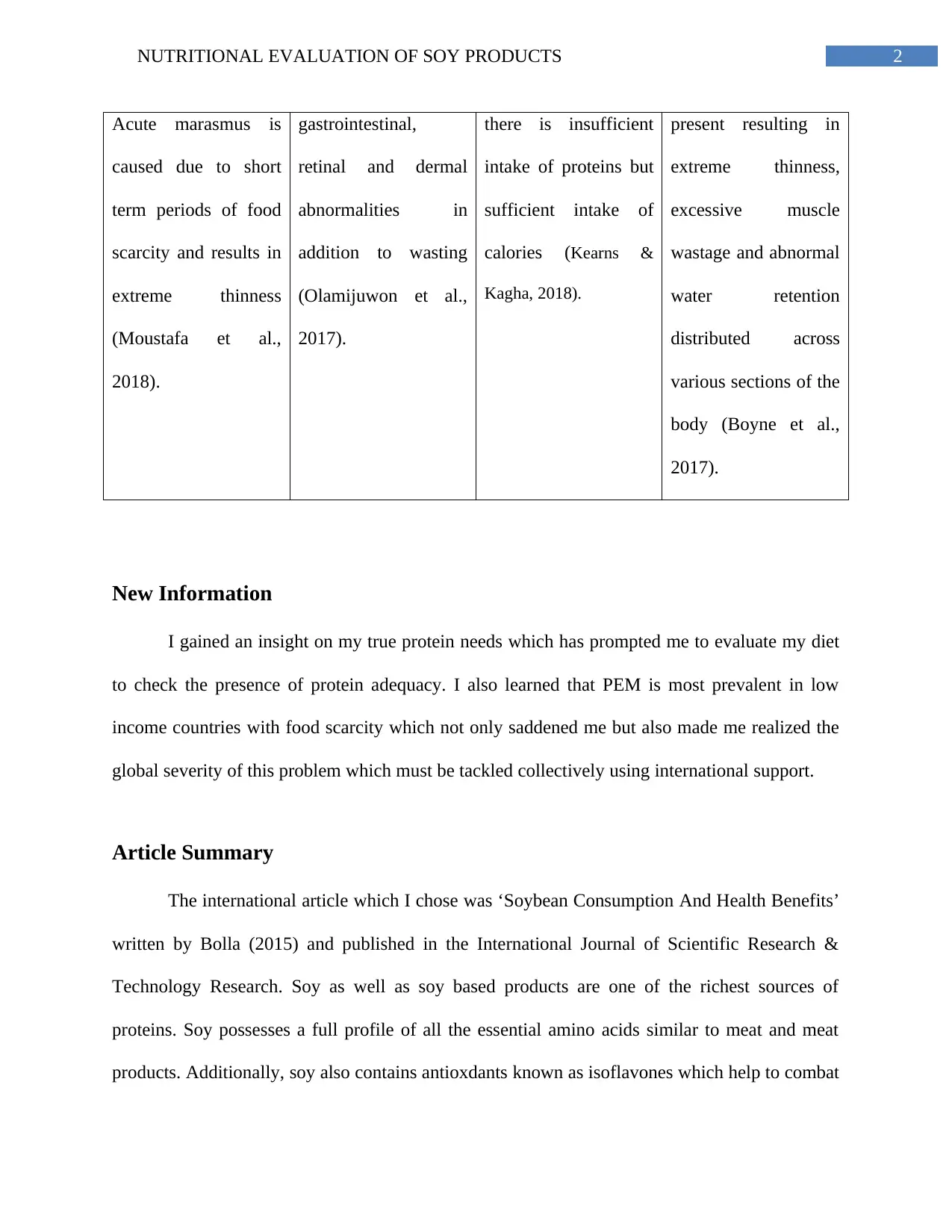
2NUTRITIONAL EVALUATION OF SOY PRODUCTS
Acute marasmus is
caused due to short
term periods of food
scarcity and results in
extreme thinness
(Moustafa et al.,
2018).
gastrointestinal,
retinal and dermal
abnormalities in
addition to wasting
(Olamijuwon et al.,
2017).
there is insufficient
intake of proteins but
sufficient intake of
calories (Kearns &
Kagha, 2018).
present resulting in
extreme thinness,
excessive muscle
wastage and abnormal
water retention
distributed across
various sections of the
body (Boyne et al.,
2017).
New Information
I gained an insight on my true protein needs which has prompted me to evaluate my diet
to check the presence of protein adequacy. I also learned that PEM is most prevalent in low
income countries with food scarcity which not only saddened me but also made me realized the
global severity of this problem which must be tackled collectively using international support.
Article Summary
The international article which I chose was ‘Soybean Consumption And Health Benefits’
written by Bolla (2015) and published in the International Journal of Scientific Research &
Technology Research. Soy as well as soy based products are one of the richest sources of
proteins. Soy possesses a full profile of all the essential amino acids similar to meat and meat
products. Additionally, soy also contains antioxdants known as isoflavones which help to combat
Acute marasmus is
caused due to short
term periods of food
scarcity and results in
extreme thinness
(Moustafa et al.,
2018).
gastrointestinal,
retinal and dermal
abnormalities in
addition to wasting
(Olamijuwon et al.,
2017).
there is insufficient
intake of proteins but
sufficient intake of
calories (Kearns &
Kagha, 2018).
present resulting in
extreme thinness,
excessive muscle
wastage and abnormal
water retention
distributed across
various sections of the
body (Boyne et al.,
2017).
New Information
I gained an insight on my true protein needs which has prompted me to evaluate my diet
to check the presence of protein adequacy. I also learned that PEM is most prevalent in low
income countries with food scarcity which not only saddened me but also made me realized the
global severity of this problem which must be tackled collectively using international support.
Article Summary
The international article which I chose was ‘Soybean Consumption And Health Benefits’
written by Bolla (2015) and published in the International Journal of Scientific Research &
Technology Research. Soy as well as soy based products are one of the richest sources of
proteins. Soy possesses a full profile of all the essential amino acids similar to meat and meat
products. Additionally, soy also contains antioxdants known as isoflavones which help to combat
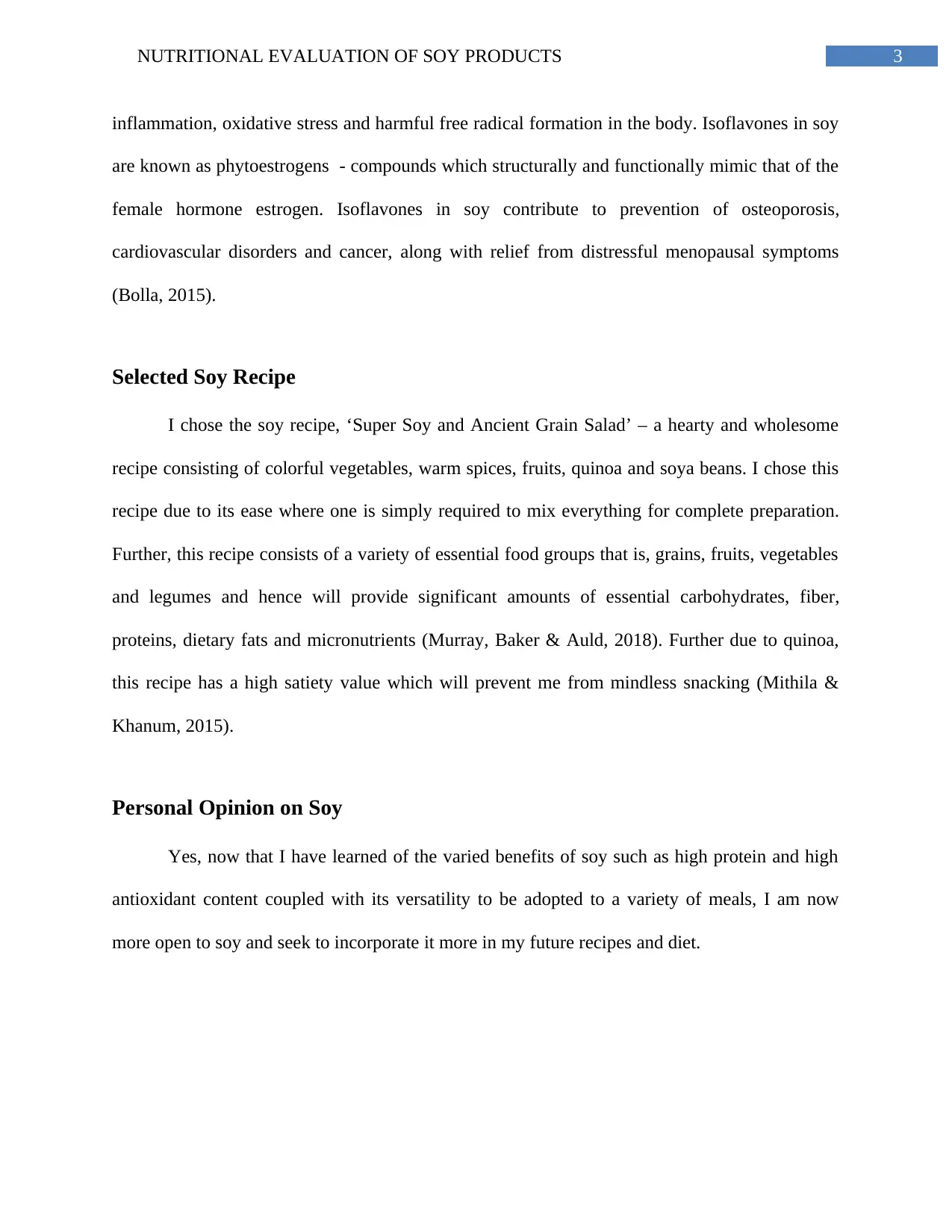
3NUTRITIONAL EVALUATION OF SOY PRODUCTS
inflammation, oxidative stress and harmful free radical formation in the body. Isoflavones in soy
are known as phytoestrogens - compounds which structurally and functionally mimic that of the
female hormone estrogen. Isoflavones in soy contribute to prevention of osteoporosis,
cardiovascular disorders and cancer, along with relief from distressful menopausal symptoms
(Bolla, 2015).
Selected Soy Recipe
I chose the soy recipe, ‘Super Soy and Ancient Grain Salad’ – a hearty and wholesome
recipe consisting of colorful vegetables, warm spices, fruits, quinoa and soya beans. I chose this
recipe due to its ease where one is simply required to mix everything for complete preparation.
Further, this recipe consists of a variety of essential food groups that is, grains, fruits, vegetables
and legumes and hence will provide significant amounts of essential carbohydrates, fiber,
proteins, dietary fats and micronutrients (Murray, Baker & Auld, 2018). Further due to quinoa,
this recipe has a high satiety value which will prevent me from mindless snacking (Mithila &
Khanum, 2015).
Personal Opinion on Soy
Yes, now that I have learned of the varied benefits of soy such as high protein and high
antioxidant content coupled with its versatility to be adopted to a variety of meals, I am now
more open to soy and seek to incorporate it more in my future recipes and diet.
inflammation, oxidative stress and harmful free radical formation in the body. Isoflavones in soy
are known as phytoestrogens - compounds which structurally and functionally mimic that of the
female hormone estrogen. Isoflavones in soy contribute to prevention of osteoporosis,
cardiovascular disorders and cancer, along with relief from distressful menopausal symptoms
(Bolla, 2015).
Selected Soy Recipe
I chose the soy recipe, ‘Super Soy and Ancient Grain Salad’ – a hearty and wholesome
recipe consisting of colorful vegetables, warm spices, fruits, quinoa and soya beans. I chose this
recipe due to its ease where one is simply required to mix everything for complete preparation.
Further, this recipe consists of a variety of essential food groups that is, grains, fruits, vegetables
and legumes and hence will provide significant amounts of essential carbohydrates, fiber,
proteins, dietary fats and micronutrients (Murray, Baker & Auld, 2018). Further due to quinoa,
this recipe has a high satiety value which will prevent me from mindless snacking (Mithila &
Khanum, 2015).
Personal Opinion on Soy
Yes, now that I have learned of the varied benefits of soy such as high protein and high
antioxidant content coupled with its versatility to be adopted to a variety of meals, I am now
more open to soy and seek to incorporate it more in my future recipes and diet.
Secure Best Marks with AI Grader
Need help grading? Try our AI Grader for instant feedback on your assignments.
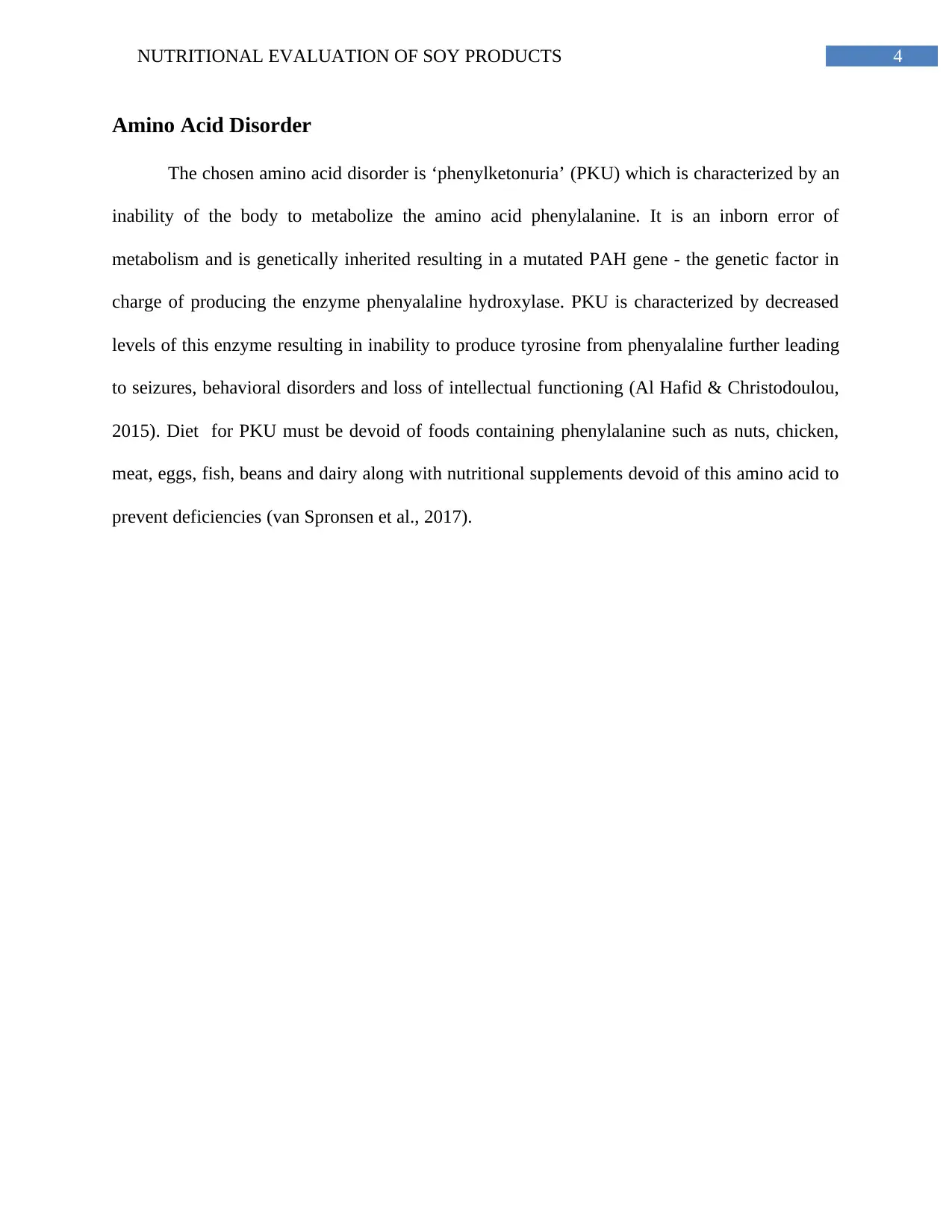
4NUTRITIONAL EVALUATION OF SOY PRODUCTS
Amino Acid Disorder
The chosen amino acid disorder is ‘phenylketonuria’ (PKU) which is characterized by an
inability of the body to metabolize the amino acid phenylalanine. It is an inborn error of
metabolism and is genetically inherited resulting in a mutated PAH gene - the genetic factor in
charge of producing the enzyme phenyalaline hydroxylase. PKU is characterized by decreased
levels of this enzyme resulting in inability to produce tyrosine from phenyalaline further leading
to seizures, behavioral disorders and loss of intellectual functioning (Al Hafid & Christodoulou,
2015). Diet for PKU must be devoid of foods containing phenylalanine such as nuts, chicken,
meat, eggs, fish, beans and dairy along with nutritional supplements devoid of this amino acid to
prevent deficiencies (van Spronsen et al., 2017).
Amino Acid Disorder
The chosen amino acid disorder is ‘phenylketonuria’ (PKU) which is characterized by an
inability of the body to metabolize the amino acid phenylalanine. It is an inborn error of
metabolism and is genetically inherited resulting in a mutated PAH gene - the genetic factor in
charge of producing the enzyme phenyalaline hydroxylase. PKU is characterized by decreased
levels of this enzyme resulting in inability to produce tyrosine from phenyalaline further leading
to seizures, behavioral disorders and loss of intellectual functioning (Al Hafid & Christodoulou,
2015). Diet for PKU must be devoid of foods containing phenylalanine such as nuts, chicken,
meat, eggs, fish, beans and dairy along with nutritional supplements devoid of this amino acid to
prevent deficiencies (van Spronsen et al., 2017).
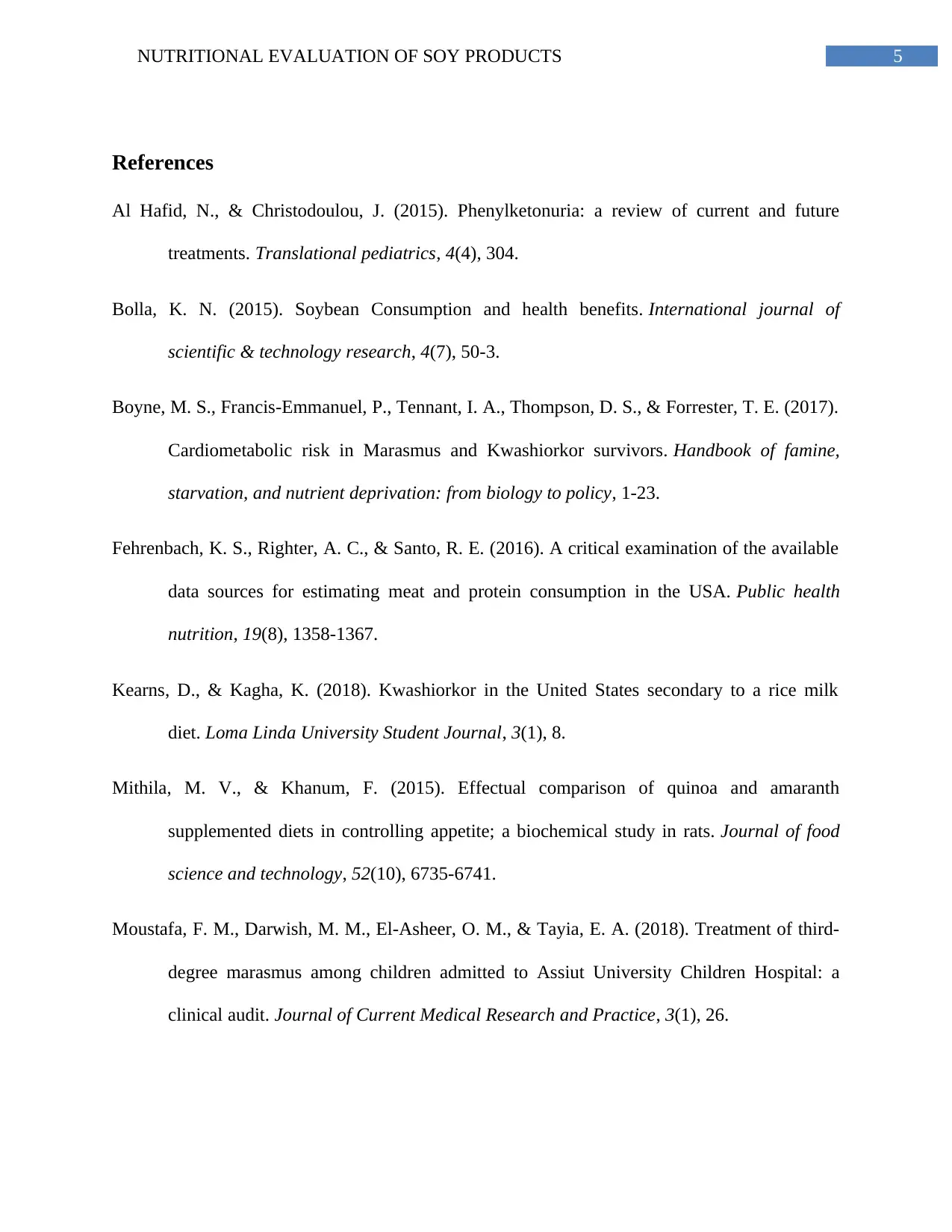
5NUTRITIONAL EVALUATION OF SOY PRODUCTS
References
Al Hafid, N., & Christodoulou, J. (2015). Phenylketonuria: a review of current and future
treatments. Translational pediatrics, 4(4), 304.
Bolla, K. N. (2015). Soybean Consumption and health benefits. International journal of
scientific & technology research, 4(7), 50-3.
Boyne, M. S., Francis-Emmanuel, P., Tennant, I. A., Thompson, D. S., & Forrester, T. E. (2017).
Cardiometabolic risk in Marasmus and Kwashiorkor survivors. Handbook of famine,
starvation, and nutrient deprivation: from biology to policy, 1-23.
Fehrenbach, K. S., Righter, A. C., & Santo, R. E. (2016). A critical examination of the available
data sources for estimating meat and protein consumption in the USA. Public health
nutrition, 19(8), 1358-1367.
Kearns, D., & Kagha, K. (2018). Kwashiorkor in the United States secondary to a rice milk
diet. Loma Linda University Student Journal, 3(1), 8.
Mithila, M. V., & Khanum, F. (2015). Effectual comparison of quinoa and amaranth
supplemented diets in controlling appetite; a biochemical study in rats. Journal of food
science and technology, 52(10), 6735-6741.
Moustafa, F. M., Darwish, M. M., El-Asheer, O. M., & Tayia, E. A. (2018). Treatment of third-
degree marasmus among children admitted to Assiut University Children Hospital: a
clinical audit. Journal of Current Medical Research and Practice, 3(1), 26.
References
Al Hafid, N., & Christodoulou, J. (2015). Phenylketonuria: a review of current and future
treatments. Translational pediatrics, 4(4), 304.
Bolla, K. N. (2015). Soybean Consumption and health benefits. International journal of
scientific & technology research, 4(7), 50-3.
Boyne, M. S., Francis-Emmanuel, P., Tennant, I. A., Thompson, D. S., & Forrester, T. E. (2017).
Cardiometabolic risk in Marasmus and Kwashiorkor survivors. Handbook of famine,
starvation, and nutrient deprivation: from biology to policy, 1-23.
Fehrenbach, K. S., Righter, A. C., & Santo, R. E. (2016). A critical examination of the available
data sources for estimating meat and protein consumption in the USA. Public health
nutrition, 19(8), 1358-1367.
Kearns, D., & Kagha, K. (2018). Kwashiorkor in the United States secondary to a rice milk
diet. Loma Linda University Student Journal, 3(1), 8.
Mithila, M. V., & Khanum, F. (2015). Effectual comparison of quinoa and amaranth
supplemented diets in controlling appetite; a biochemical study in rats. Journal of food
science and technology, 52(10), 6735-6741.
Moustafa, F. M., Darwish, M. M., El-Asheer, O. M., & Tayia, E. A. (2018). Treatment of third-
degree marasmus among children admitted to Assiut University Children Hospital: a
clinical audit. Journal of Current Medical Research and Practice, 3(1), 26.
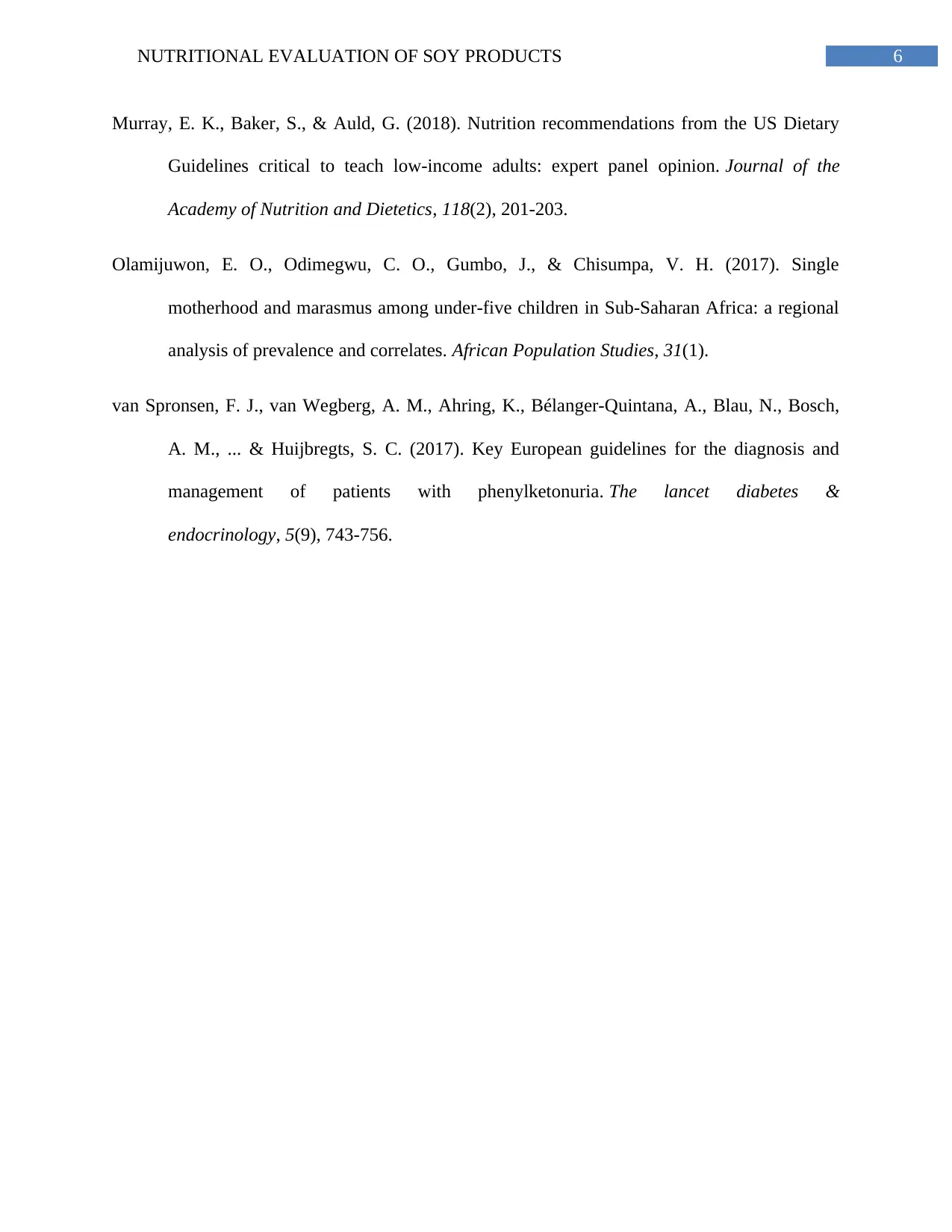
6NUTRITIONAL EVALUATION OF SOY PRODUCTS
Murray, E. K., Baker, S., & Auld, G. (2018). Nutrition recommendations from the US Dietary
Guidelines critical to teach low-income adults: expert panel opinion. Journal of the
Academy of Nutrition and Dietetics, 118(2), 201-203.
Olamijuwon, E. O., Odimegwu, C. O., Gumbo, J., & Chisumpa, V. H. (2017). Single
motherhood and marasmus among under-five children in Sub-Saharan Africa: a regional
analysis of prevalence and correlates. African Population Studies, 31(1).
van Spronsen, F. J., van Wegberg, A. M., Ahring, K., Bélanger-Quintana, A., Blau, N., Bosch,
A. M., ... & Huijbregts, S. C. (2017). Key European guidelines for the diagnosis and
management of patients with phenylketonuria. The lancet diabetes &
endocrinology, 5(9), 743-756.
Murray, E. K., Baker, S., & Auld, G. (2018). Nutrition recommendations from the US Dietary
Guidelines critical to teach low-income adults: expert panel opinion. Journal of the
Academy of Nutrition and Dietetics, 118(2), 201-203.
Olamijuwon, E. O., Odimegwu, C. O., Gumbo, J., & Chisumpa, V. H. (2017). Single
motherhood and marasmus among under-five children in Sub-Saharan Africa: a regional
analysis of prevalence and correlates. African Population Studies, 31(1).
van Spronsen, F. J., van Wegberg, A. M., Ahring, K., Bélanger-Quintana, A., Blau, N., Bosch,
A. M., ... & Huijbregts, S. C. (2017). Key European guidelines for the diagnosis and
management of patients with phenylketonuria. The lancet diabetes &
endocrinology, 5(9), 743-756.
1 out of 7
Your All-in-One AI-Powered Toolkit for Academic Success.
+13062052269
info@desklib.com
Available 24*7 on WhatsApp / Email
![[object Object]](/_next/static/media/star-bottom.7253800d.svg)
Unlock your academic potential
© 2024 | Zucol Services PVT LTD | All rights reserved.